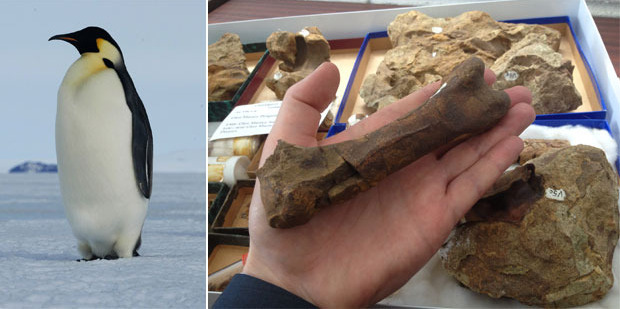Friday Nov 28, 2014

The fossilised bones of the penguin, yet to be named, were found in North Waikato in 1971, but had been largely ignored until recently rediscovered by Massey University zoologist Dr Daniel Thomas.
The unusual features of the 28-million-year-old specimen have convinced Dr Thomas it is a new species, and the first of its kind to be discovered in the North Island.
Dr Thomas estimates the bird would have stood at 1.3m - slightly taller than the ancient Kairuku penguin discovered in 2012, and about 30cm taller than today's largest penguin, the emperor. "I imagine an emperor would have run away scared," said Dr Thomas, when asked how the two birds would compare. It was likely the bird would have been a deep-diving penguin, like the emperor, and been preyed upon by sharks and dolphins.
He learned about the remains shortly after returning to New Zealand from overseas and searching through old research papers. Because there was little to compare the remains against when they were discovered, the specimens were not fully classified and were eventually shelved in a Tamaki storage shed operated by the University of Auckland. "It turned out there was a raft of other specimens as well - it was a treasure trove of some really incredible stuff."
It was when he came upon the right leg bone of the penguin - enough to immediately tell him much about the bird - that the significance of the discovery struck him. "I couldn't stop grinning, to be honest ... I was looking at this thing and thinking, how has no one worked on this for 40 years?"
Dr Thomas had the bones 3-D-scanned and sent the prints to colleague Dr Dan Ksepka in the United States for further analysis. Features in the bones of the fossil penguin were different from any of the 50 discovered so far, and Dr Thomas and his colleagues now have only to confirm its status as a juvenile or adult before they can prepare a paper for peer review.
The find was especially exciting for Dr Thomas as the fossil was recovered near where he grew up, and he sees potential for many more new discoveries to be made in the North Island. He is keen to hear from Waikato and King Country farmers with limestone quarries who could help with the hunt.
3 Penguin facts
1. An unnamed ancient penguin whose fossilised bones were recently rediscovered in an Auckland storage shed lived 28 million years ago when most of New Zealand was underwater. 2. It is likely to have stood just over 1.3m tall - slightly taller than the recently discovered ancient Kairuku penguin and 30cm taller than the largest existing penguin, the emperor.
3. It is believed to be the first specimen of its type discovered in the North Island and raises exciting possibilities of what other wonders may lie preserved inside the North Island's hills and limestone quarries.
source
*******************************************************************************
Fossil find reveals new giant penguin
Olivia Allison, Environment/Science Reporter
28 November 2014
Dr Daniel Thomas with the fossil.
Photo: RNZ / Olivia Allison
This has allowed Massey University's Dr Daniel Thomas to scan the bones to American paleontologist Dr Daniel Ksepka. Both were then able to determine that they are "almost certain" it was a new type of giant penguin.
The penguin was dated by taking a fragment of the rock the bones were encased in and looking at fossil plankton. Records of fossil plankton are vast, so Dr Thomas said it was easier to determine the date.
Dr Thomas said penguin fossils become accessible as parts of the North Island that were once under water rose up over time. He could tell it was a giant penguin by comparing the thigh bone of the fossil to other penguins.
Emperor penguins are about 1 metre tall and have a thigh bone half the size of the fossil bone. Dr Thomas said it had been compared with another fossil giant penguin also, allowing them to guess that it was about 1.3 metres tall.
Dr Thomas said it did not appear to have any links to emperor penguins, other than the fact they were both penguins. "Because it lived so far back in time, it's not a close link - they'd be very distant relatives. Definitely not a cousin or step-cousin."
As researchers only have one leg bone and other fragments, they could not tell what body shape the penguin had or its weight. But they could guess with near certainty that it was black and white, just like penguins today.
Dr Thomas said it was likely the penguin would have been a deep diver, travelling offshore to find fish. He said the discovery was very big, as it was the first North Island fossil giant penguin to be discovered. "Africa has fossil humans, America has fossil dinosaurs, we have a few dinosaurs, but I like to think of New Zealand as a place with giant penguins. It feeds into the idea that New Zealand is really special."
source




















